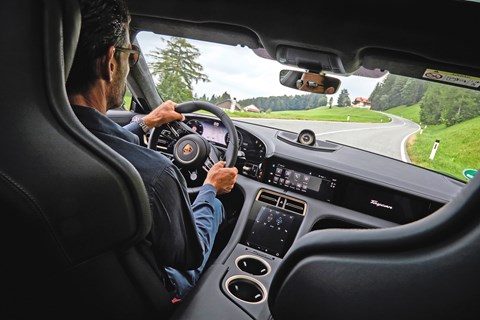► Testing out Taycan’s regeneration
► Tech uses cameras to adjust recoup
► How does it work in the real world?
The figures are impressive enough. The Porsche Taycan is a two-tonne car capable of 0-62mph in under three seconds, with braking power to match. The front calipers on the Turbo and Turbo S have 10 pistons apiece, with six on the 4S. A big stop in a Taycan feels like galloping into a patio door.
But it’s not only discs and pads doing the stopping, it’s regenerative braking too – e-motors go into reverse to recharge the batteries and shed speed. Despite all the hardware, the algorithms and the blend between regen and regular braking, it’s impressive just how natural the feedback feels.
There are actually three regen modes selectable via a button on the wheel. One feels like normal engine braking, another is regen off, and there’s the camera-based adaptive mode we’re testing.
Unlike other EVs, the Taycan prioritises coasting over recuperation when you release the throttle. It’s more efficient, says Porsche, and gives the car a more natural feel than the sudden loss of speed we’ve come to associate with battery-powered vehicles – that feeling familiar to Nissan Leaf drivers, as if you’ve lobbed an anchor out of the window every time you take your foot off the accelerator. The Taycan’s adaptive system offers something like normal engine braking in steady-state driving but increasing in severity when the car detects traffic. Like adaptive cruise control, but more subtle and on all the time.
Significantly, Porsche’s Surface Coated Brake discs are standard. They use a layer of drill-bit-tough tungsten carbide to reduce wear and resist corrosion. Porsche reckons 90 per cent of day-to-day braking will be done by the recuperation system, leaving a set of standard iron discs at serious risk of furring up. The service schedule shows the pads need attention – but not necessarily replacing – every six years; that’s how little wear they’ll get.
It’s only possible for those vast, powerful brakes to be the secondary means of slowing down because the regen system is so powerful, even if it feels natural and unintrusive. Up to 265kW can be clawed back at deceleration of 3.8 m/s2. This is a lot, but unlike most regen systems you don’t notice it when you ease off the accelerator, only when you press the brake pedal, and even then it’s hard to tell which system is being used.
Recuperation cam: how it works

Pick your mode
Adaptive regeneration is selected using a button on the wheel. A fixed recuperation mode and resistance-free coasting are also available.

Forward looking
Taycan’s adaptive system picks how much it slows down when you release the accelerator, based on information from the front-mounted camera.

Default to cruising
If it sees a clear road it wants to coast, using your kinetic energy rather than needlessly slowing. If there’s a car ahead, it’ll ramp up the regen.
Does it work?
Yes. It works very well indeed, dialling in the level of recuperation you need, so there’s no need to adjust it using the shifter paddles like on most EVs, and no riding the accelerator or pogoing on and off the gas in traffic to compensate for over-zealous regenerative brakes. It’s intuitive and makes for a relaxing, wafty drive. Until you stand on the gas and give everyone neck-ache, of course.
Check out more CAR Tech news here